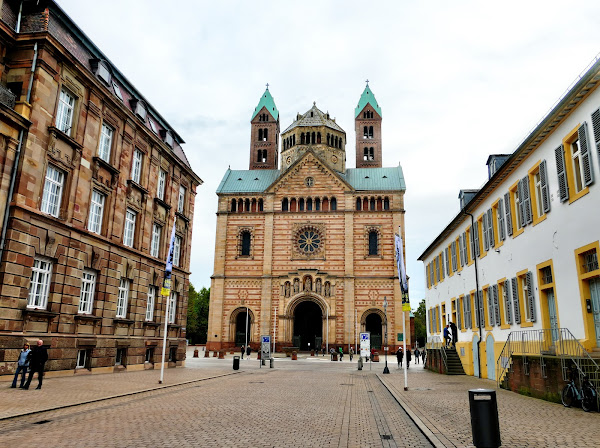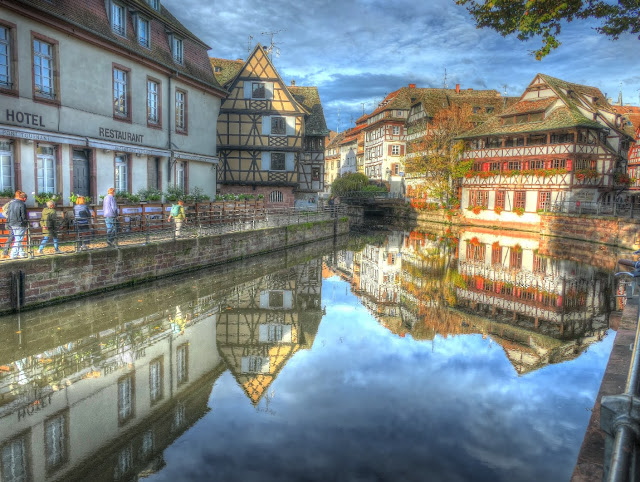Basel Switzerland
_Enhancer_small.jpg) |
| Middle Rhine Bridge: First constructed in 1224 and reconstructed in 1905. It was the first bridge over the Rhine at Basel and the first bridge between Lake Constance and the North Sea |
We left Rochester on an evening flight to Dulles Airport in Washington where we connected to an eight-hour flight to Munich on Lufthansa. After a connecting flight to Basel that afternoon, we were checked into our extremely comfortable Movenpick Hotel. Since we had a two-day pre cruise extension, Viking handled all the transfers. All we had to do was walk out with our little red stickers on and be taken in a Mercedes van into town. Quite luxurious.
The next day we took a two-hour walking tour with our Viking Guide, Rachel. The first thing you notice is how people move around particularly in the center city. There are no cars! Only one in three residents own autos. There is an excellent public transportation system with both buses and trams. They operate on multiple routes with an average wait time of 7.5 minutes system wide. Since this is Switzerland, the information is precise rather than the American inclination to round up or down. The other thing you notice are bicycles everywhere. While these may be used for recreation, their primary use is transportation to work and school. Pedestrians need to be conscious of bikes and the constantly moving trams. The latter ring bells and blow horns while the former are quiet and constantly moving in and out of pedestrian traffic. You quickly learn that it is fruitless and even dangerous to try to out maneuver them.Unfortunately, one of the other things we noticed was the amount of smoking. Any outdoor eating venue always included ashtrays on the tables and usually one or two smokers. We had forgotten what that was like since back home even outdoor areas are non-smoking. Our first tip off was in the Munich Airport where smoking areas were sponsored by my Dad's old brand, Camels. Our anecdotal information is borne out by research. According to a report by Cutler and Glaeser published by the National Bureau of Economic Research, "among richer countries and people, higher incomes are associated with less smoking. This can account for about one-fifth of the U.S./Europe difference. Almost one-half of the smoking difference appears to be the result of differences in beliefs about the health effects of smoking; Europeans are generally less likely to think that cigarette smoking is harmful." It takes at least a generation for smoking habits to change, and the Europeans began public education later than the Americans.
The first stop in the walking tour was right outside our hotel where an insurance company had gathered its employees to reveal its new logo. There were around 100 people in business attire all holding blue balloons which they released on cue. It was a nice opportunity for a video which I captured and then uploaded to YouTube. My account was promptly given a warning about showing a public demonstration. Within five minutes that warning was removed. This was my first experience with European Union social media regulations. People in Europe and especially in France are very aware of the dangers of terrorism. Remember the attacks on Charlie in Paris and the tragedy in Nice. Hopefully I am correct, and you can see the video below without my account being frozen.
We spent the day walking around the old city of Basel, half the time with the group and then on our own. The major highlights were the Basel Minster and the Rathaus or City Hall. The Minster or Cathedral sits atop the highest point in the city above the Rhine. It was built between 1019 and 1500. The original Romanesque building was destroyed by an earthquake in 1356 and rebuilt in the Gothic style. When we returned later in the day, we decided to go inside and pay a four Swiss franc entrance fee so we could see more. As we opened a door, we were confronted with a set of what looked like original stairs leading up into the tower. We decided to give it a go but couldn't make it to the top. There was one point where we had to transfer between two sets of stairs without any railings so we had to crawl between the two. We got through that but saw still more stairs even steeper and narrower. We got close but no cigar. This reminded me of my experience with Byers Peak in Colorado.
 |
| Käppelijoch |
We learned something unexpected about Switzerland. If look at the photo of the Middle Bridge above, you will notice a small structure on the center column. A closeup image is to the left. This is a reconstruction of a small chapel or Käppelijoch that was used to prepare people accused of being witches before they were launched into the Rhine and a death by drowning. Surprisingly, Switzerland holds the record for the number of witches executed per capita. Even more surprising, the last execution was in 1782, six years after the Declaration of Independence in America. Another fact of which I was not aware is that Switzerland is not part of the European Union and hence uses its own currency, the Swiss franc, which they maintain at about par with the euro and the U. S. dollar.
The interior of the Minster is impressive. It would be the first of many cathedral-like churches we would experience on our trip. This one started out as Roman Catholic but was handed over by the City to the Swiss Reformed Church in 1529. "During the iconoclasm of the Protestant Reformation, many valuable pieces of art belonging to the city of Basel and the minster were destroyed in 1528 and 1529. Numerous citizens stormed many of the churches in Basel, some of them by armed force in order to demolish religious paintings and statues." (Wikipedia) While much was lost or destroyed, the treasury of the cathedral was preserved and is now displayed in the Basel Historical Museum.
_Balanced.jpg) |
| The interior of the Basel Minister. Other than the stained-glass windows, there is little decoration. |
.jpg) |
| Erasmus von Rotterdam |
The interior held another surprise, the burial vault of Erasmus of Rotterdam. He was a, if not the, leading figure of Christian humanism in the Northern Renaissance. His philosophical and theological works influenced Thomas More and Ignatius Loyola as well as Martin Luther and Huldrych Zwingli. He remained faithful to the Catholic Church but committed to reforming both its theology and practices. He was in Basel when he died unexpectedly in 1536 and was buried in what was by then as a Swiss Reformed church.
.jpg) |
| Barfusserplatz |
The next day we spent the morning at the Basel Historical Museum which was founded in 1894 and is one of forty in Basel. The museum is located in a former Franciscan monastery. This was built in 1309 and was known as the Barfüsserkirche or the church of the bare foot ones as the Franciscans were called. In 1529 it passed to the City of Basel and the location became known as Barfüsserplatz or Bare Foot Plaza. The building went through many different uses before becoming the home of this impressive museum.
By 1:00 we had returned to our hotel where met up with our local Viking hosts who had arranged for our luggage and us to be transported to the longship Mani on the Rhine. It was a short ten-minute trip. We began to explore the ship on this rainy afternoon. By 2:00 we were in our stateroom where our bags had been delivered. We attended a safety briefing and went through a drill. We then attended a cocktail reception in the lounge where we met the crew leadership and heard briefings about the cruise and what to expect next day. By 7:30 we were sitting down to dinner as the ship left Basel for Breisach, our first stop.

.jpg)



Comments
Post a Comment